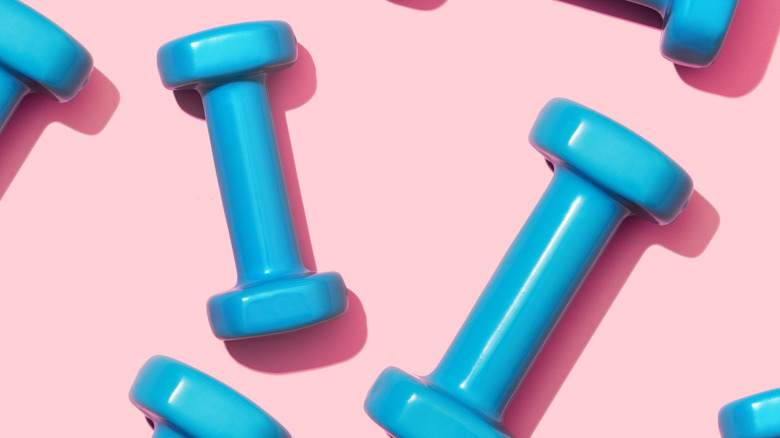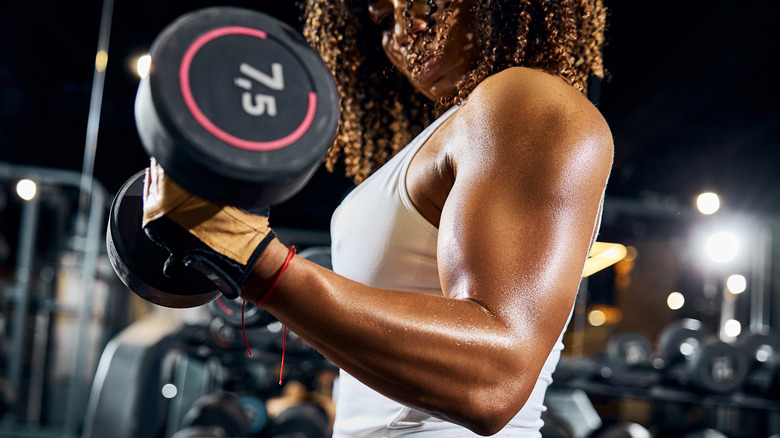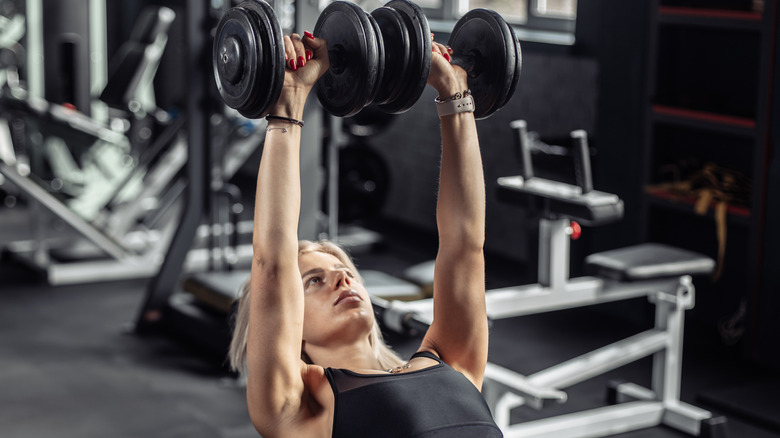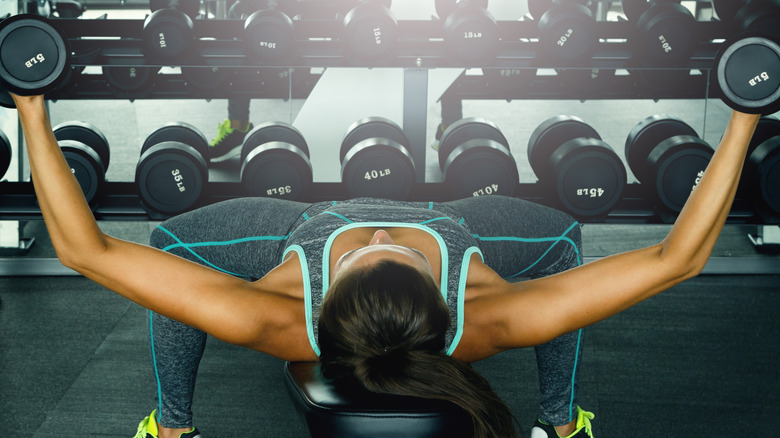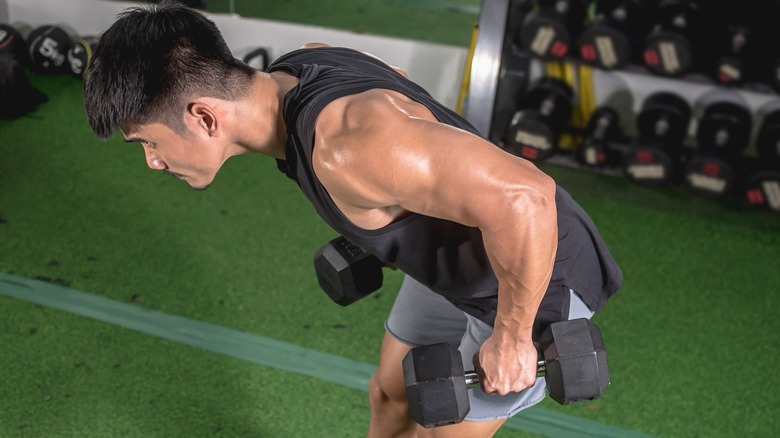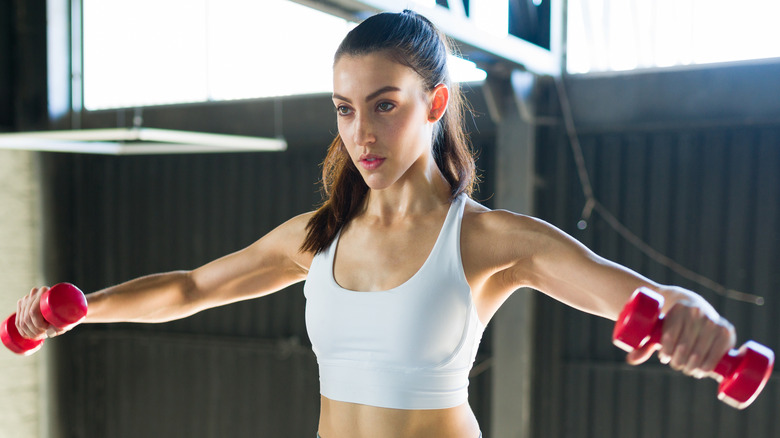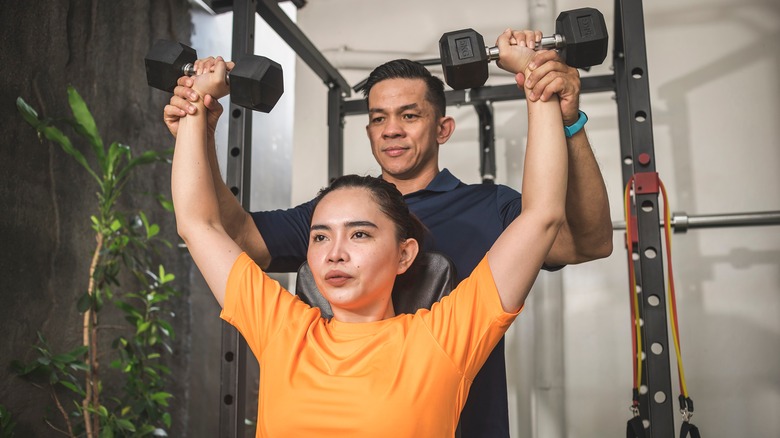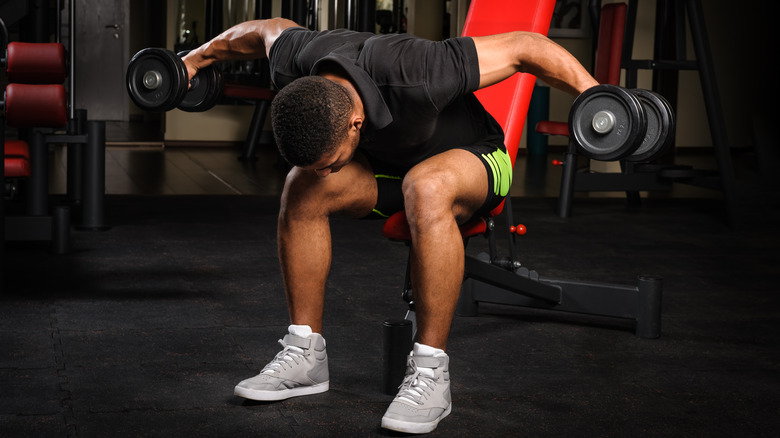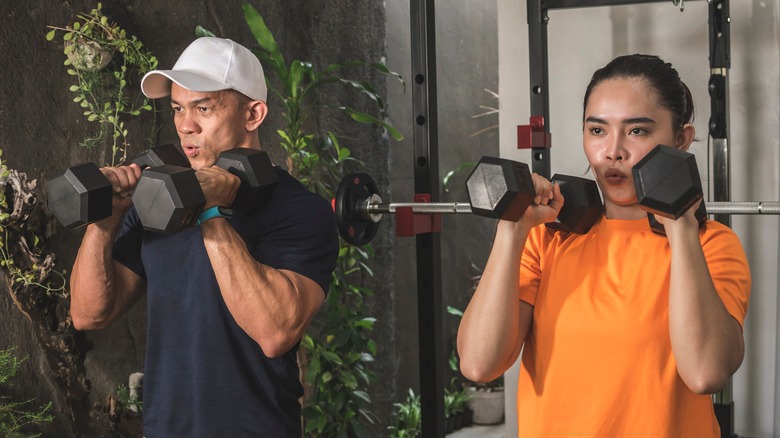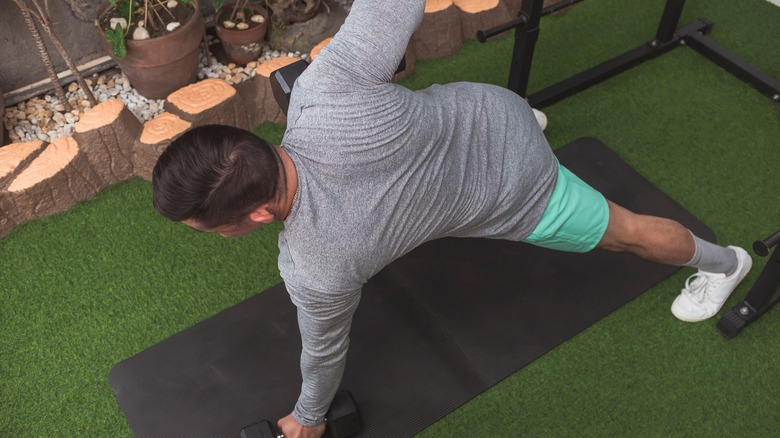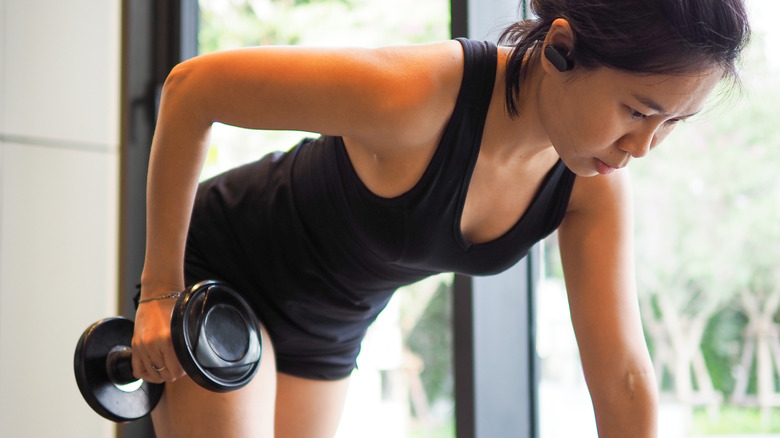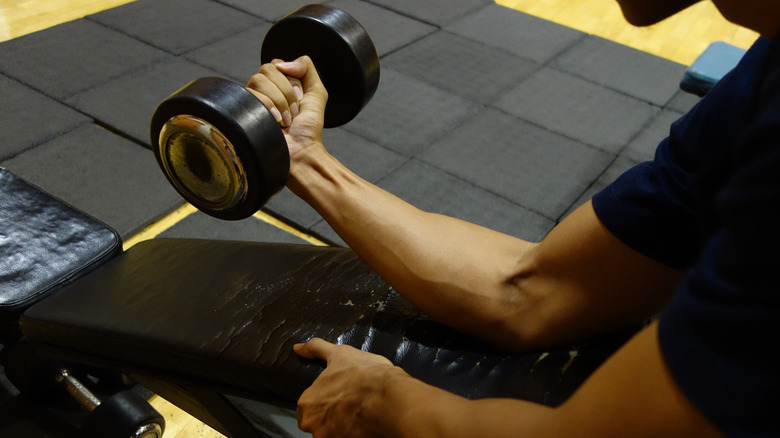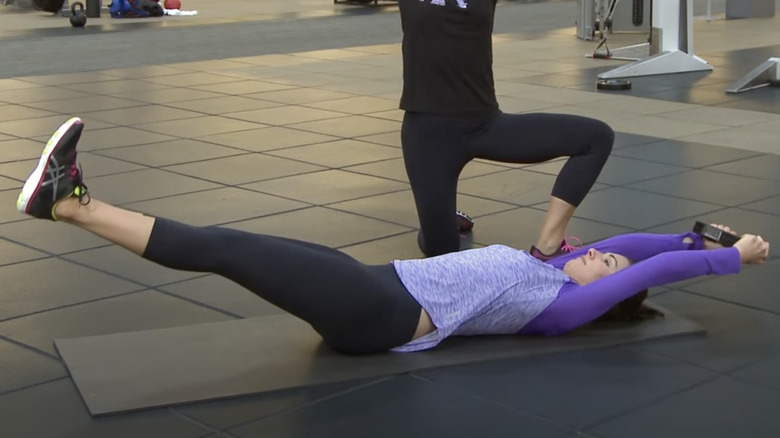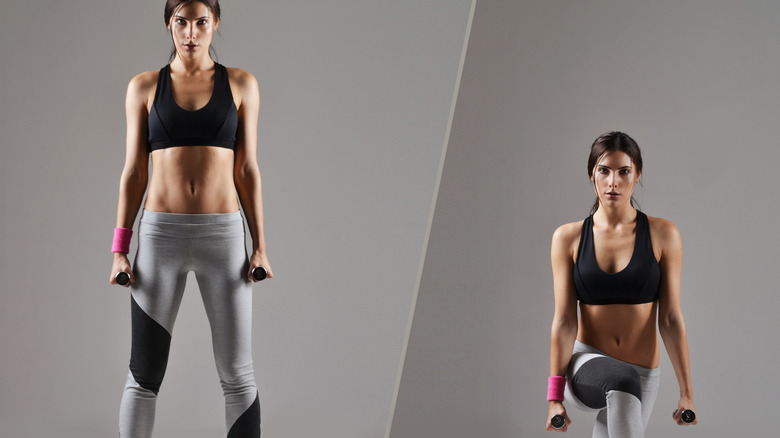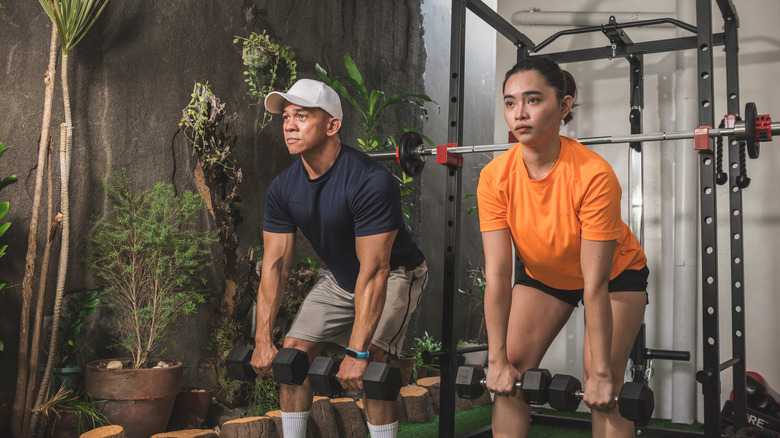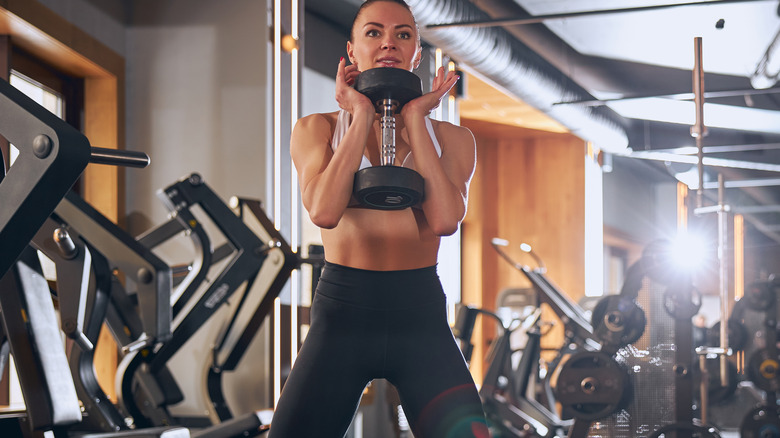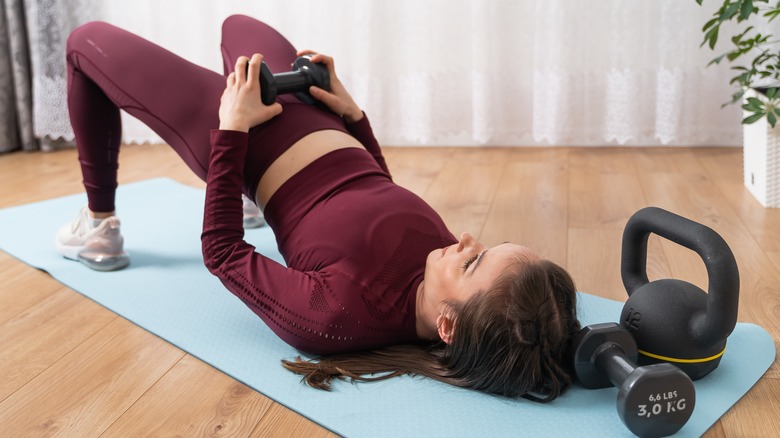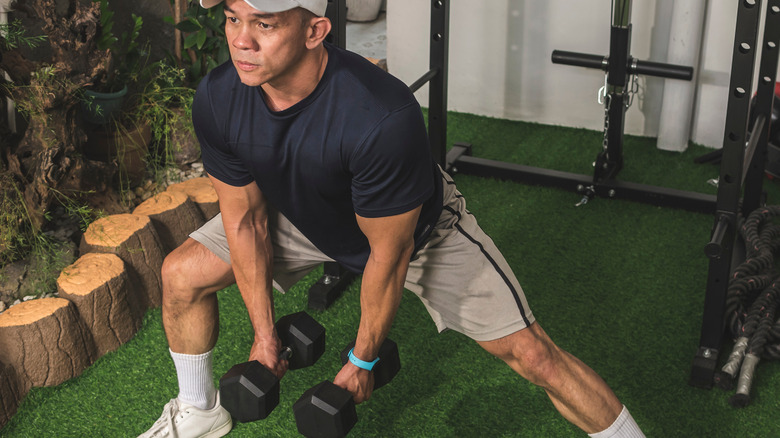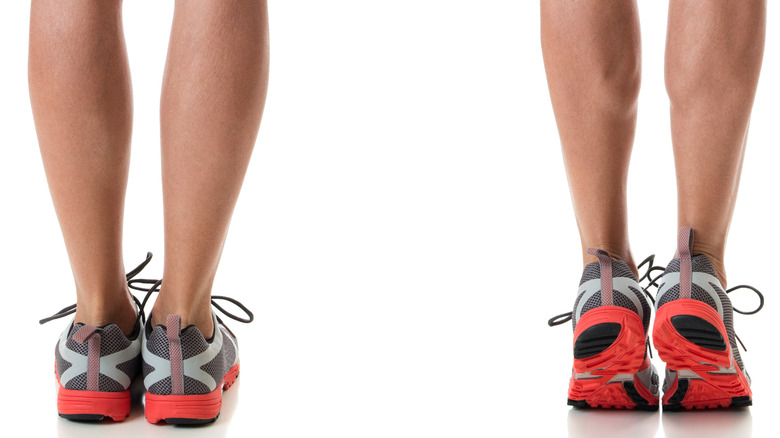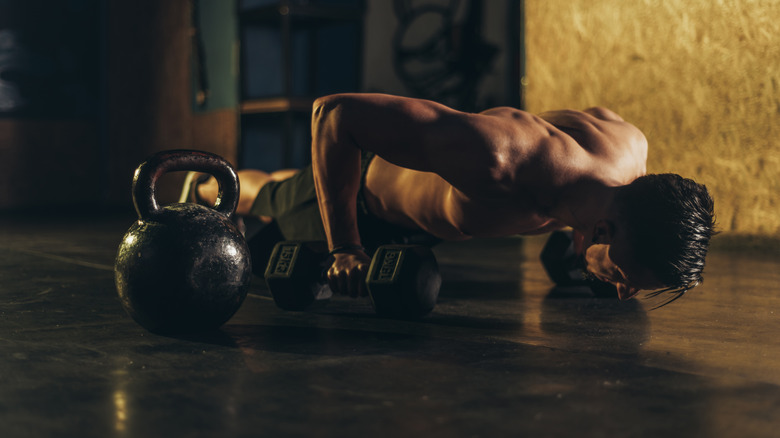The Best Exercises You Can Do With Dumbbells
Whatever level of fitness you're at, dumbbells are your friends. You can't set foot in a single gym around the world without finding the super-versatile piece of equipment, and for good reason: They can do pretty much anything.
"Dumbbells are an excellent low-cost option for strength training and even metabolic conditioning," says Dallas' Cooper Fitness Center's fitness director Mary Edwards (via WeightWatchers). Equally at home being used during resistance-based activities and more cardio-focused workouts, dumbbells are not only super-portable and usually small enough to fit subtly into the corner of any room, but they're also affordable and easy to get hold of, Edwards states. And pretty much any staple exercise — from workouts that target your back to those that build your lower body strength — can be augmented through the use of dumbbells. Plus, they'll make you feel like a fitness pro.
But, with the massive range of exercises on offer with dumbbells, where do you even start? It feels like there are so many variations of workout moves that it's hard to know which ones are the best. That's why we decided to, once and for all, put together a list of our top choices for dumbbell exercises. Grab your weights, and let's dive in.
Bicep curl
Of all the dumbbell exercises out there, surely this one comes out on top. Arguably the workout move that people associate with dumbbells the most, the bicep curl is an unparalleled way to build your bicep muscles (per Muscle & Strength). Begin by standing with your feet shoulder-width apart, with a dumbbell in each hand, hanging by each side with your palms facing forward. Then, curl each weight up with your forearm, either alternating sides or curling both of them at the same time, until your forearm is at a 90-degree angle to your upper arm. Squeeze your biceps at the top of the curl, and then slowly lower them down to the starting position, for one rep.
While the bicep curl may seem simple, there are a few key things you need to watch out for to make sure they're as effective as can be. Watch out for whether you're swaying to create momentum on your lift, advises fitness trainer Ben Booker from Second Chance Fitness (via GQ). This will often occur when people are using weights that are too heavy for them. When you find you're doing this, you can either reduce the amount of weight lifted, or try performing bicep curls with your back to a wall or while sitting down, which will help you limit the movement.
Bench press
Do you want rippling, toned chest muscles? Of course you do! (Well, maybe you don't, and that's okay, we love you all the same.) And if toning your chest is on your agenda, then you really can't get better than a bench press using dumbbells.
Focusing on your pectoralis major muscles as well as the muscles in your shoulders and arms, begin a bench press by holding a dumbbell in each hand and lying flat on your back on an exercise bench, says Healthline. Your arms should be at a 90-degree angle to your body, with the weights at chest height. With your feet flat on the ground, gradually push the weights directly upward, until your arms are extended. Then, lower your arms back down, stopping when your elbow goes just beyond your body.
During your bench press, keep an eye on the position of your shoulders. "This is critical. Shoulder injuries are common on the bench, and very often, that's because of poor shoulder position," says certified strength and conditioning specialist Ebenezer Samuel (via Men's Health). Keep your shoulders engaged during the movement, ensuring that they're coming back into the bench when your arms are fully extended. You should also make sure that your back muscles remain engaged throughout the exercise.
Chest flye
While you may have seen people performing a chest flye (or chest fly) using a fly machine, we guarantee you that doing them with dumbbells will supercharge your gains. Often forgotten about in favor of the bench press, the chest flye targets your pecs effectively. "Doing chest flyes is a great way to isolate the chest. "Most pressing chest movements will enlist the help of the shoulders and triceps, but flyes keep the focus purely on the chest," says personal trainer Ant Nyman (via Coach Magazine).
To do a chest flye, you'll also need an exercise bench, although you can perform them on the floor, too. Lie down on your bench, holding a dumbbell in each hand (palms facing up), with your arms extended out to your sides and your feet planted firmly on the floor. Then, draw your hands in to meet each other, keeping your arms extended, so your dumbbells are moving in an arcing motion above your torso. Return your arms to the starting position, for one rep. Make sure that your elbows don't lock while you're doing the exercise. It's also worth generating a slightly more pronounced lower back arch while you're doing it. "This will help keep the tension on your chest as opposed to your shoulders," says Nyman.
Bent-over row
How do you work out your back? Using a weight machine, or on a rowing simulator, perhaps? Well, we'd urge you to pick up the dumbbells and try the bent-over row instead. The bent-over row is an awesome way to target several major muscles in your back, as well as your core, according to certified personal trainer Betina Gozo (via Women's Health Magazine). And as a bonus, your arm muscles will also get a sweet workout.
Start by standing with your feet at hip-width, with a dumbbell in each hand, and then gradually bend forward so that your upper body is parallel to the ground. You should have a gentle bend in your knees, and your arms should be hanging slack in front of your body. Then, in a rowing motion, pull each hand back so that your elbows drive behind your body, pulling your shoulder blades together as the weights come to meet your chest. Hold the position here briefly, and then lower your arms to the starting position. If you have lighter weights, try to aim for up to 15 reps, whereas for bent-over rows with heavier weights, aim for a maximum of 12.
Lateral raises
When we talk about having more "toned" shoulders, it's arguable that we really mean "wider." And a pair of wide shoulders can be easily achieved through lateral raises with a pair of dumbbells, especially if you're a novice with the weights. "Lateral raises target the medial (outer) head of the deltoid muscle. You don't need an awful lot of core strength to perform the movement, which is why it's good for beginners," says personal trainer Ant Nyman (via Coach Magazine).
Stand with your back straight, and hold a dumbbell on each side of your body. Then, as though you're spreading a pair of wings, pull your dumbbells up, palms facing down until your arms are outstretched on either side. Your weights should come up to around the level of your neck, with a slight bend in your elbows. Then, lower the dumbbells back to your beginning position. As a bonus to your form, slightly rotate your hands when you get to the top of the movement, as though you were pouring a bucket of water onto the floor. "This will ensure you hit the medial head as opposed to over-developing the front delt," states Nyman.
Shoulder press
When you're thinking about moves to work on your shoulders, the shoulder press is pretty high on everyone's list. And performing them with dumbbells is something you won't go back from. By doing a shoulder press with dumbbells, you're ensuring that you're spreading the weight across each muscle equally, instead of leaning into one shoulder to do all of the work (per Coach Magazine). This leads to better-rounded, stronger delts.
Start your shoulder press by standing with your feet shoulder-width apart, or, if you prefer, sitting on an exercise bench, which may help you work with heavier weights. Lift your dumbbells so that they're slightly above your shoulders, with your palm facing towards the wall in front of you. Then, as the name suggests, press the weights above your head, activating through the shoulder, avoiding locking your elbow at the top of the motion. Hold your weights at the top of the motion briefly, and then slowly lower your hands back to the first position.
Reverse fly with dumbbells
If you've ever wanted to pretend to be a bird (and if you haven't, what's wrong with you? Oh, you haven't? ... Oh, none of you have? Okay, no, we don't do that either, that's weir-), this one's for you. The reverse fly with dumbbells is an awesome way to target your upper back, as well as the backs of your shoulders (per Men's Health), a traditionally tricky area to work out. And all you need is a pair of dumbbells (and a will to take flight).
Begin by standing up normally, holding a dumbbell in each hand, and then bend your body forward so that your back's flat, facing the ceiling. Make sure that your feet aren't placed too narrowly, and that your knees and your elbows are slightly bent. The arms and your dumbbells should be hanging down loosely from your shoulders. Then, without jerking or swaying your torso too much, pull your arms out to either side, as though you're spreading wings until they're fully extended on each side of your body. Hold this outspread position at the top briefly, and then lower your weights back down.
Dumbbell clean
Although we tend to think of dumbbells as being best suited to exercises that target just one part of the body, they can also be used to work multiple muscle groups in one go. The dumbbell clean is the perfect exercise to do this. A favorite of bodybuilders and powerlifters, this simple move hits an almost dizzying amount of muscles, including much of your lower body, your shoulders, and your traps, say Muscle & Fitness.
Stand with your feet placed at the width of your shoulders, with a dumbbell in each hand, by your sides. Then, bend your knees so you come down to a semi-squat position, and then push your body back up, using the momentum this generates to place your dumbbells on your shoulders. At the top of the movement, your legs should be fully extended (but not locked). Hold the position here, and then release your dumbbells back down to the starting position, by your sides. Working quickly is key here: Try to use explosive power throughout, while making sure you retain control.
Renegade row
Few moves are as challenging, or as rewarding, as the renegade row. Combining a dumbbell row and a plank, it's a multi-purpose move that utilizes dumbbells effectively (per Women's Health Magazine). Keep in mind that while your arms are the most mobile aspect of the renegade row, you're gonna need to fire up your core pretty strongly to keep the move useful, advises certified strength and conditioning specialist Harris Murrieta.
Begin by moving into a plank position, but with a dumbbell in each hand, balancing the weights on the floor so that you're propped up holding them. Then, keeping your core engaged so it doesn't pivot, draw one hand off the floor, and row it backward. Slowly return the weight to the floor, and repeat with the other hand.
Make sure that your shoulders and wrists are directly aligned, says certified strength and conditioning specialist Ebenezer Samuel (via Men's Health). If your hands are too wide apart, it creates instability and may put pressure on the joint. You also need to try, as much as possible, not to twist your hips as your arm rows back, so that you get the maximum activation through your muscles.
Tricep kickback
Okay, so our triceps may not be as glamorous as our biceps, but they play an essential part in the everyday movements of our elbow and shoulder (per Healthline). And tricep kickbacks are one of the best ways to work them out using dumbbells. The most important thing to consider with this exercise is the weight of the dumbbell you choose: Try not to overexert yourself, and pick a pair of dumbbells that allow you to complete your reps and sets fully, while still offering a good amount of resistance.
Start by standing with your feet shoulder-width apart, and a dumbbell in each hand, hanging by your sides. Then, gradually lean your upper body forward from the hips, until it's almost parallel to the floor. Make sure that your core is activated and your back is flat, and bring your upper arms in line with your upper body, so your elbow is bent. Slowly extend your arms out fully, so that the weight is moving backward until your arms are straight. You should feel an activation through the tricep while you do so. Bend your arm to return it to the starting position, for one rep.
Take note, though, that if you are unable to perform this exercise correctly, there is a very high risk of injuring your shoulders and elbows. If this exercise is just too complicated for you to pull off properly, absolutely do not force it.
Wrist curls
In all of the working out we do involving our larger muscles, our forearms can sometimes be forgotten about. But they really shouldn't be: Forearm strength is a super-important aspect of fitness and everyday life, with proper grip and forearm power helping us to do everything from carrying our luggage to twisting open awkward objects (per the National Federation of Professional Trainers). But working out our forearms can be a tricky thing to figure out how to do — until now, that is. Enter wrist curls, the ideal move to do with a pair of dumbbells.
Start by kneeling in front of a bench and placing your forearms on it, with your wrists hanging over the side and a dumbbell in each hand (per Coach). Then, with your palms facing up, gradually roll the dumbbells using your wrists upward, like a little mini-bicep curl, until they're at their maximum range of motion. Squeeze your forearms briefly at the top, and then allow the weights to roll back down to the starting position.
Dumbbell suitcase crunch
Dumbbells and ab exercises don't seem to naturally go hand-in-hand. But the truth is, using dumbbells as part of an ab exercise is a really effective way to add further resistance and supercharge your core gains. Moves like the dumbbell suitcase crunch allow you to forego endless reps of normal crunches and give your abdominals more to work against, according to Bodybuilding.com. And they're pretty much as easy as doing a regular sit-up.
Start as you would with a normal crunch, lying on the floor with your back flat, but with a dumbbell held above your head, lying flat on the floor. Your legs should also be straight out in front of you, instead of bent. Then, slowly bring your legs up off the floor, and pull your knees towards your core, while simultaneously lifting the weight over your head to meet your toes. Your body should make a "U" shape at the top of the motion. Hold the pose briefly, with your abs drawn in, and then slowly lower your arms and legs back to the starting position.
Curtsy lunge
If you've ever wanted to practice your best "Bridgerton"-style etiquette while simultaneously training your lower body, then the curtsy lunge is for you. This unique exercise targets a muscle area that is pretty hard to train at the best of times, your inner thighs, and when you add dumbbells for resistance, it can give your legs an even better burn (per Women's Health Magazine).
A curtsy lunge is similar to a regular backward lunge, but with a unique difference. Start as you would before a backward lunge, with your feet shoulder-width apart, and with a dumbbell in each hand. Then, take a big step back — and, crucially for a curtsy lunge, cross your leg over your stabilizing leg. The clue's in the name: It should feel as though you're doing an over-the-top curtsy. Make sure that your back remains straight and your core is engaged as you lunge backward, and avoid twisting your torso. Step your leg back up, to return to starting position, for one rep. Then, repeat on the other side.
Dumbbell Romanian deadlift
The dumbbell Romanian deadlift doesn't just have a cool name — it's also a very cool exercise. And when we say "cool," we mean "incredibly effective and useful," of course. The dumbbell Romanian deadlift will target your full posterior chain, the group of muscles that runs down your back, and includes your glutes, hamstrings, and lower back, says Women's Health Magazine. And all you need is a pair of dumbbells to do it.
Hold a dumbbell in each hand, and stand up straight, with your feet placed at hip-width. Your dumbbells should be resting gently on the front of your thighs. Then, gently start to move your hips back towards the back wall, while your torso hinges forward. "My favourite cue for nailing this movement is imagining you want to close a draw behind you with your bum," says Beyond Fitness Coaching founder Jake Van't Hoff. Your dumbbells should gradually start to lower down your thighs until they pass your knees. Once they're at their lowest position and your back's parallel to the ceiling, lift back up, activating through the glutes.
Goblet squat
There are squats, and then there are goblet squats. This supercharged squat takes a dumbbell and adds it into the mix, with the weight held in front of you increasing resistance while simultaneously protecting your back (per Healthline).
Place your feet slightly wider than hip-width, and hold the weight in front of you with both hands, by one end. (It should resemble a goblet, hence the name.) Making sure that your knees are over your feet, squat down on an inhale, ensuring that your core is engaged while you do so. Squat until your upper legs are at a 90-degree angle with the floor, sending your hips back. Then, drive up through your feet to return to your starting position.
There are a few key mistakes you should watch out for with goblet squats, to make sure they remain effective. Try not to let your upper body bend forward, which indicates that you haven't kept your core tight while you're working out. It could also be the case that you're allowing the weight to hang too much. Try to maintain alignment between your knees and your feet, too, to stop your knees from twisting.
Weighted glute bridge
Working on your glutes is an essential aspect of any fitness routine, to help both shape your physique and create additional power in your lower body (per Pop Sugar). And while there are loads of ways to do this, the glute bridge is pretty much the most direct exercise you can do – and adding a dumbbell into the movement will make your glutes positively sing.
To do a weighted glute bridge, grab yourself a fairly heavy dumbbell, and lay with your back flat on the floor, your feet placed flat on the ground. Put your dumbbell on top of your hips, just below your belly button, and make sure you're holding on to it with both hands so it doesn't slide around. Then, drive your hips up towards the ceiling, activating your glute muscles while you do so. Your abs should be engaged, too, with your body coming into a straight line. Maintain this position for a few seconds, and then return your body to the ground, for a single rep. Repeat twelve times per set.
Dumbbell side lunge
Few exercises work your legs like a lunge, and a side lunge amps it up to the next level. When performed using dumbbells (or without), side lunges activate your hamstrings, glutes, and quads, while also generating a serious stretch through your groin (per Sweat).
Start by taking your dumbbells and holding them up to your chest, with your feet planted firmly on the ground and your back and core straight. On an inhale, lift one of your feet off the ground, and step it out to the side. When the foot lands on the ground, bend your leg into a lunge position, making sure that your knee is going over your foot, and not kipping out to the side. Your lunge should be as deep as you're able to go, without destabilizing you too much. Then, when exhaling, push your knee back up and return to your standing position. Repeat with the opposite leg, for a full rep, completing as many reps and sets as you require.
Standing calf dumbbell raise
Hey, don't forget about the little guys, folks. When we work out our lower body, so much emphasis goes into our upper leg muscles (our hamstrings, glutes, and quads), that we can often forget about our calves. But a standing dumbbell calf raise can help you tackle this problem efficiently, working out your gastrocnemius muscles to create well-toned legs, says Bodybuilding.com.
Performing a standing calf dumbbell raise couldn't be simpler, either. To begin, you'll need to find a small step or a wooden board (of around several inches tall) and then stand with your toes on it, with your heel hanging off the edge. You can also perform this move with your feet flat on the ground, without a step. Hold a dumbbell in each hand, with your hands hanging by your sides. Then, gradually raise your body, using the front of your foot, so that you're almost standing on your toes, on an exhale. You should feel your calf activate as you do this. Hold the position at the top for several seconds, and then lower your feet back to the ground. Repeat as many times as you require. Trust us, this exercise will put a serious pump through your lower legs.
Dumbbell push-up
Who says that regular bodyweight exercises can't be jazzed up by using a dumbbell? Not us! And we're a huge fan of taking the good old-fashioned push-up and blowing it out of the water by adding some dumbbells into the mix. The dumbbell push-up may seem more challenging, and indeed, it can create a better pump through your chest by "making the range of motion bigger and the push-ups deeper," according to certified personal trainer Vanessa Windt (via Livestrong). But dumbbell push-ups may also be kinder to your wrists than regular push-ups, while also potentially making them a little easier to perform, thanks to your body being higher up.
To do a dumbbell push-up, grab a pair of dumbbells and kneel on the floor. Place the dumbbells in front of you, gripping them in each hand and making sure they're at shoulder-width, and then place your feet back behind you so that your body's in a plank position. Then, gradually lower your body down, with your elbows extending out and behind you, until your body's parallel to the floor. Push your body back up to complete the push-up.

